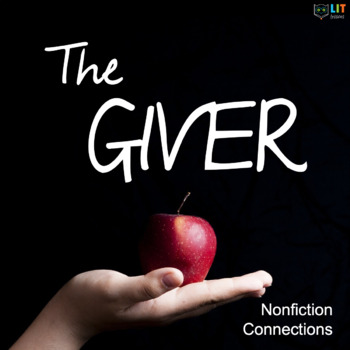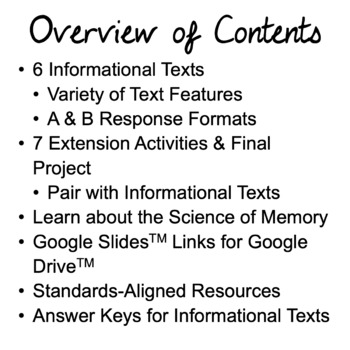The Giver Informational Texts & Activities
- Zip
Also included in
- The Giver Novel Study is a comprehensive novel study for teaching The Giver by Lois Lowry. This novel study provides unique opportunities to implement an engaging exploration of this classic book. Whether you have taught The Giver for years or it is your first time, The Giver Novel Study will providPrice $20.00Original Price $32.00Save $12.00
Description
The informational texts will build your students’ knowledge about memory, the brain, and the processes involved in memory formation. Students will learn about the brain’s structures, brain plasticity, and the different types of memories that shape our everyday lives. When synthesized with a reading of The Giver, the information will prompt critical thinking and analysis about the significance of memory in day-to-day life. By the end of this unit of study, students will have developed their ability to think critically, make connections between texts, and examined the importance of memory for individuals and society.
The Giver Informational Texts & Extension Activities - Snapshot of Resources Included:
- 6 Informational Texts
- Variety of Text Features
- A & B Response Formats
- 7 Extension Activities & Final Project
- Pair with Informational Texts
- Learn about the Science of Memory
- Google Slides™ Links for Google Drive™
- Standards-Aligned Resources
- Answer Keys for Informational Texts
PLEASE NOTE: This The Giver resource includes many identical readings and activities in the Restart by Gordon Korman Novel Study Informational Texts & Activities resource. Please DO NOT purchase both. If you are interested in both novel studies, reach out for special discount pricing at lauren@lit-lessons.com. Thank you!
Informational Texts: The 6 informational texts about memory include two sets of questions – one comprehension set and one analysis set – that will develop essential skills aligned to the reading of informational and historical texts under the Common Core State Standards. The readings also allow for differentiation, accommodation, and flexible implementation. After working with these texts over the course of a unit, you can be confident your students will have mastered numerous skills and built their background knowledge on numerous topics, including:
- What Is Memory?
- Types of Memory
- Memory & the Brain
- From the First Memories…
- …To the Last Memories
- The Malleability of Memories
The 7 extension activities and final project will engage learners by having students synthesize the novel alongside the informational texts. They will apply their learning to not only analyze the novel but also deepen their understanding about the science of memories. As they do so, they will sharpen their critical thinking abilities and practice essential skills aligned to the reading of informational and science texts under the Common Core State Standards. The activities include the following:
- Brain vs. Computer: Students will apply their learning about the science of memories through this activity. Students will use question stems to conduct research about the computer and the human brain, comparing and contrasting their capabilities. Then, students will take a stance about whether the computer or the human brain is superior.
- Working on Memory: The “Working on Memory” set of activities engages students in a series of fun brain games. These challenges are a great way to help students hone their working memory skills, exercising this part of working memory in real-time. Feel free to play these games for a class period, use them as bell ringers, or end each class with a working memory challenge. A PowerPoint and PDF of the materials needed to play are included! Please note that image elements (clipart) are not editable.
- Mapping Memories: This activity has students make connections between the informational text “Memory & the Brain” and their own memories. Students will journal about a chosen memory and identify which part of the memory is stored in which region of the brain.
- First Memories: For the first memory activity, students will write a narrative, capturing the essence of their first memory as vividly as the memories included in The Giver. Through brainstorm, writing, and connecting their recollection to the informational texts, students will continue to develop a comprehensive understanding about the science of memories.
- Creating Collective Memories: Memories can adapt, change, and be altered as they are retrieved time and time again. For the collective memory activity, students will write about, share, and rewrite a memory, taking note of how their peers’ memories may influence personal recollection.
- Text Connections: The text connections resource sees students synthesizing the informational texts and the novel. They will make cross-curricular connections between the texts, activities, and the novel, The Giver. Students consider how their new knowledge about memory intersects with Jonas’ story.
- Neuroplasticity: If time permits or early finishers need an additional assignment, use the Neuroplasticity activity! This activity involves students listening to a TED Talk about brain plasticity and answering questions about it. It can be completed individually, in small groups, or as a whole class. It is an additional assignment for you to use as you see fit.
- Final Project – The Giver Memory Book: After reading The Giver and considering the importance of memory to the human experience, students will synthesize their learning through the memory book final project. The project will ask them to engage and analyze the memories in the novel, consider their importance, ponder what is missing, and propose memories that add more depth and complexity to the human experience as presented to characters in the novel.
Digital Links: This resource is also technology friendly! It can be utilized in classrooms where computers or tablets are central to instruction because the resource has been adapted for digital completion. The resource includes links for students to complete the student pages in Google Slides™. For instance, students can work with the documents in Google Drive™ or via Google Classroom. With these links, you can have students complete their work online. There are links for every student work page, making the format friendly not only for technology but also trees.
Answer Key & Rubrics: The key provides potential answers for all informational texts and rubrics are provided for applicable extension activities. Of course, not all analytic questions have just one answer, especially when based on research. Part of the strength of the analysis question is the room they leave for students to demonstrate their unique thinking and use textual evidence to support their stance. Therefore, use the answers at your discretion but know they provide a solid foundation for the type of performance that makes for quality work.
The entire resource and its inclusive set of questions allow for multiple potential uses based on your determination about when and where it would be most helpful. All aspects of the assignments, though, are aligned to the Common Core State Standards in order for students to have ample opportunities to practice and demonstrate their knowledge across numerous, essential literary skills.
This resource is NOT EDITABLE. It is intended to be comprehensive, but if you have particular needs for your classroom, please contact me! (lauren@lit-lessons.com)






